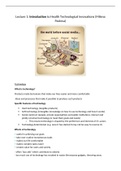Lecture 1: Introduction to Health Technological Innovations (Milena
Pavlova)
Technology
What is technology?
Products made by humans that make our lives easier and more comfortable
Ideas and processes that make it possible to produce such products
Specific features of technology
Hard technology (tangible products)
Soft technology (intangible; knowledge on how to use technology and how it works)
Social construct (people, private organisations and public institutions, interact and
jointly construct technology to meet their goals and needs)
o This means technology is shaped by the preference and interests of it’s actors
Technology determinism (e.g. once it has started it may not be easy to reverse it)
Effects of technology
+ useful in achieving our goals
+ take over routine monotonous tasks
+ makes our life comfortable
+ makes complex tasks easier
+ creates value for users and society
- offers ‘lazy aids’ which contribute to obesity
- too much use of technology has resulted in waste (throwaway gadgets, throwing away
,after upgrading etc)
- environmental pollution
- creates stress if not used properly
Health technology
What is health technology?
WHO: “A health technology is the application of organised knowledge and skills in the form
of devices, medicines, vaccines, procedures and systems developed to solve a health
problem and improve quality of lives”
Health technology:
Concerns both hard and soft technology
Is shaped by social construction
Is adapted to specific conditions (customise the healthcare products and services to
the needs of individual patients)
Evolves over time
Is a social construct
The role of health technology
Priority areas:
Emerging and recurring public and population health threats
Social, economic, and physical conditions and environments, which significantly
impact health and wellbeing
o E.g. Technology improves access to healthcare for people living in remote or
rural areas
Complexity of population health issues, which increasingly emphasise the
importance of working together
Health technology innovation
What is innovation?
Various definitions:
New, better, and more effective ways of solving problems
A new idea, device, or method
The act or process of introducing new ideas, devices, or methods
In healthcare, the term describes policies, systems, technologies, ideas, services, and
products that provide solutions to existing healthcare problems
(“New” is relative – it may be new to the world, a community, or an individual)
,Innovation characteristics
3 criteria to go from an invention to an innovation:
New idea: new product, process, service, business
Exploitable: implementable and valuable idea
Successful: adopted by the targeted audience
Types of innovation
Social: new approaches to tackle social issues and solve problems
Health: new mechanisms to improve population health
Product: new goods and services within the market
Process: enhancement of the production or delivery of goods and services
This course focuses on 4 groups of innovations:
Pharmaceutical innovations
Innovative medical devices
Innovative big data applications
Innovative d-/e-/m-health apps
We will consider the role of Law, Economics, Management, Ethics, and Practice on these
groups.
Perspectives on health technology innovation
Health technological innovation and EU competencies
EU competencies
, EU legislation and regulation on pharma policy and pharmaceutical innovations,
namely clinical trials
The General Data Protection Regulation in the EU, and also focusing on electronic
patients’ records for data analysis
EU legislation and the debates in the area of medical devices, e.g. the question of
involving health consumers, providers, and decision-makers in the design of new
medical devices
Stakeholders in the area of health technological innovation in the EU, including
policymaking and institutions




